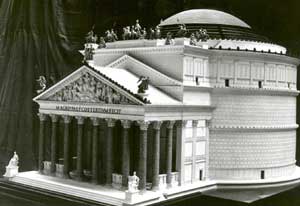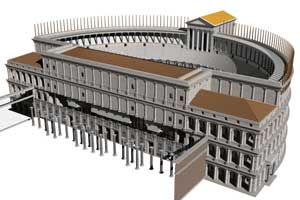3D Models in the "Pompey Project"
The 19th Century Reconstructions
Restoring the Theater of Pompey in the 21st Century:
By James Packer
3D Models in the “Pompey Project”
In order to mesh the details of plans, sections, and elevations
accurately, architects have long constructed three dimensional
models. These also gave convincing demonstrations of the future
effects of a specific design. They showed the appearance of its
forms; they demonstrated realistic plays of light and shade across
the proposed architectural fabric, and they conveyed to
non-architects a realistic impression of the future building. Indeed
without such models mistakes in plans and sections would remain
uncorrected.
In recent times, the advent of AutoCad and computer rendering
have created the three dimensional digital model. Convincingly
colored, filled with accurate details taken from on-site features in
properly realistic visualizations, these constructs show viewers
every feature from any angle. Hence the construction of our own as
yet unfinished computer model has necessarily taught us much about
the form and character of the Theater of Pompey in its various
phases, and similar reasoning led us to make 3D models based on the
reconstructions of Canina and Baltard. To both scholars and the
general public, all three models demonstrate the features envisioned
by the early archaeo-logist/architects in easily manipulated,
completely comprehensible, visually memorable three-dimensional
forms that, as further materials on the Theater come to light, may
be easily revised and sent on line to all parts of the world.
 |
|
 |
| Fig. 1. 19th century model of the Pantheon (by
Chipiez) |
|
Fig. 2. Incomplete model of the Theater of
Pompey, looking SW (John Burge, J.
Packer) |
